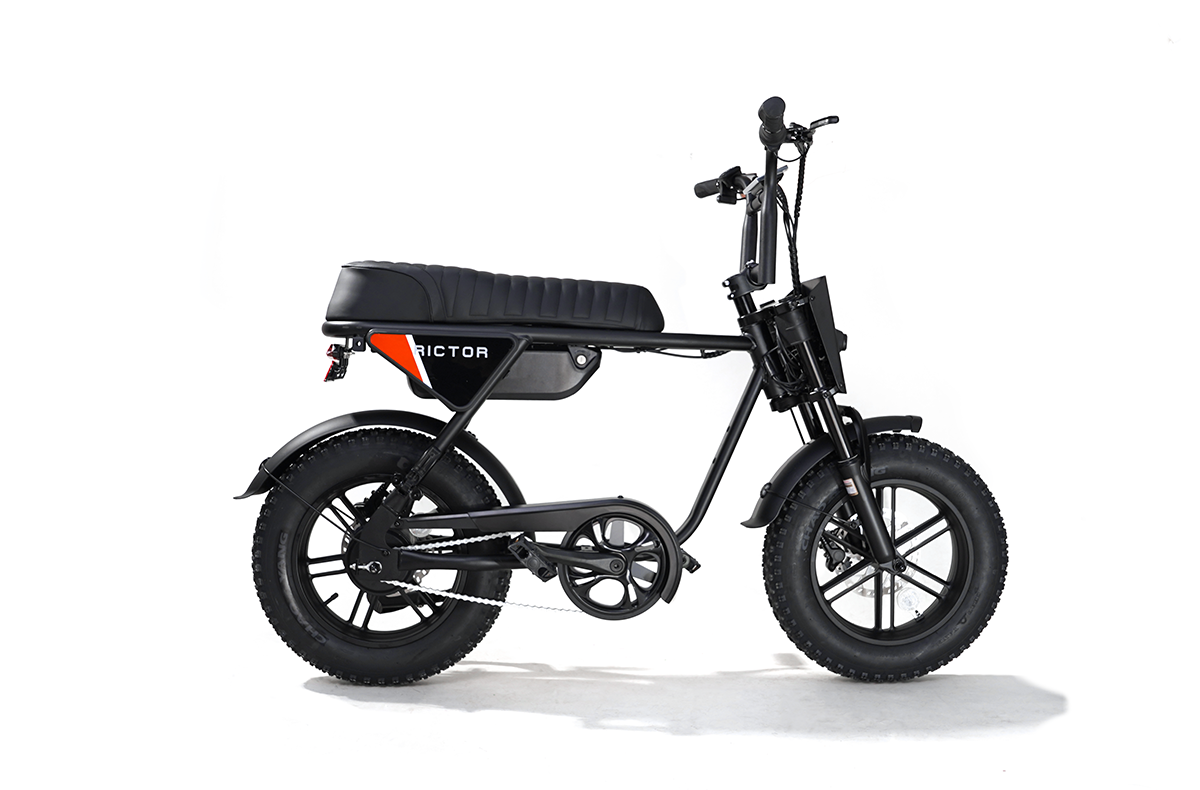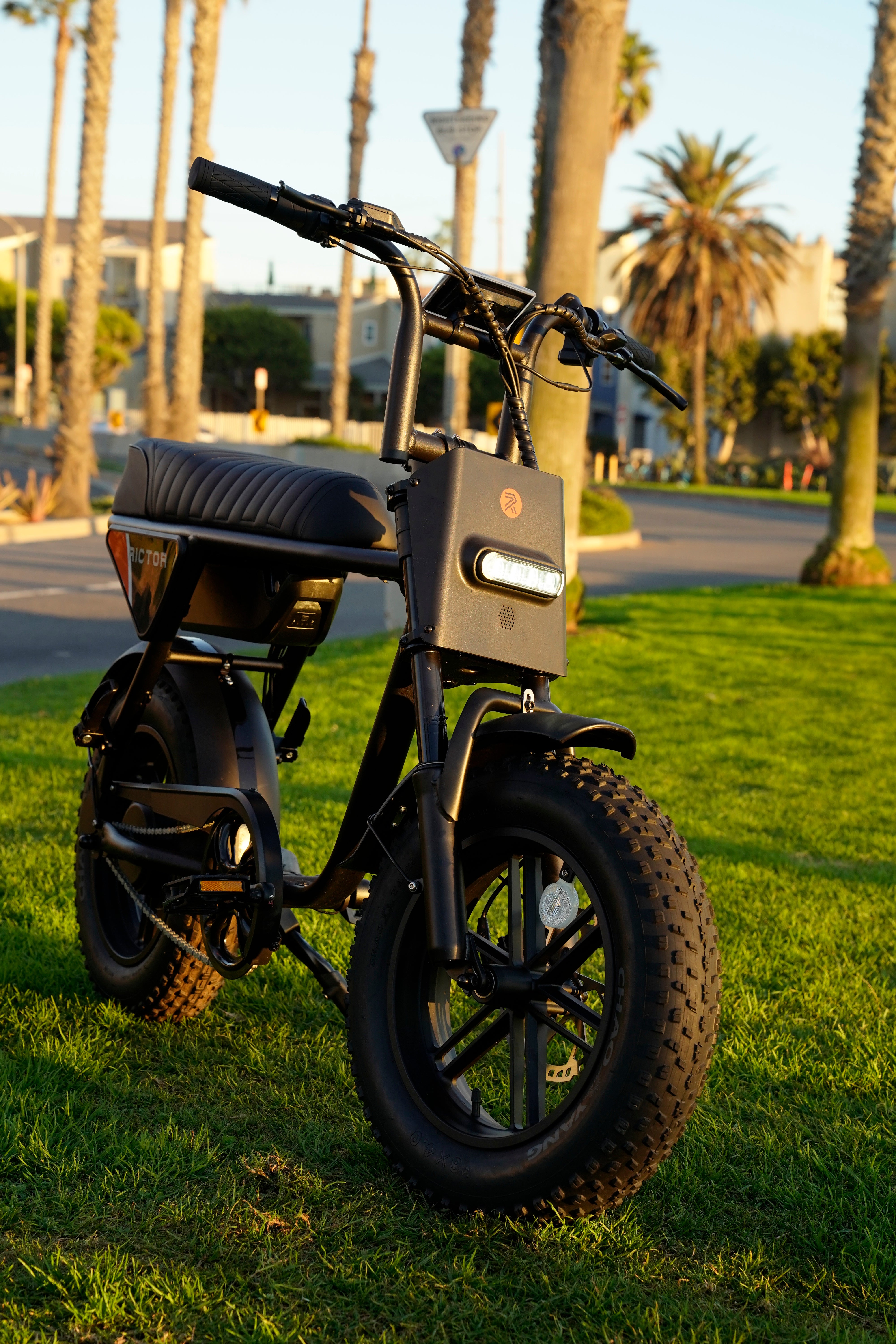
What is an Electric Bike & What to Know Before Buying
What Is an Electric Bike
An electric bike is a bicycle that features an integrated electric motor designed to assist with pedaling, offering a boost to riders.
This assistance is powered by a rechargeable battery, which is mounted on or integrated into the bike’s frame.
The main idea behind an ebike is not for the motor to replace pedaling but to provide pedal assist, making rides easier, especially over long distances or up steep hills.
Rictor K1 is a perfect example of such an ebike—K1 is even smarter. Still fumbling with your keys to unlock your bike? With the K1, all you need is the app for remote unlocking!
Below, we will break down the key components of an electric bike.

Pedal Assist and Power Modes
Ebike motors provide pedal assist, meaning they only engage when you pedal. You can choose different levels of assistance based on your needs:
Low Assistance: This mode conserves battery life while providing minimal support.
High Assistance: Delivers maximum power for tougher rides but drains the battery faster. Many ebikes also have a throttle option, where the motor can be activated without pedaling. However, the availability and legality of throttle options vary depending on local regulations. For instance:
In the United States, many Class 2 ebikes come with a throttle that allows riders to accelerate without pedaling, up to a speed of 20 mph. This makes it convenient for riders who need quick bursts of speed, such as when navigating through traffic.
In Europe, throttle use is more restricted. The EU regulations only allow throttle assistance up to 6 km/h (3.7 mph) without pedaling, meaning beyond that, you must be pedaling to receive motor assistance. This regulation is aimed at keeping ebikes closer to traditional cycling experiences while maintaining safety.
💡 Ebike Quiz!
1. How many ebike classes are there in the U.S.?
2. Does a Class 1 ebike only have pedal assist?
3. What is the top speed of a Class 2 ebike?
Motor
The motor is the driving force behind an ebike, offering the power to assist your pedaling.
Motors come in different types, each with its advantages, and the most common are hub motors, mid drive motors, and brushless motors.
Hub Motors
Hub motors are located in either the front or rear wheel hub, directly driving the wheel.
These motors are popular in more affordable ebikes due to their simplicity in design and ease of maintenance.
Since they are mounted in the wheel, hub motors do not affect the bike's drivetrain, making them less complex to install or service.
However, they can make the bike feel less balanced, especially if placed in the front wheel.
Mid-Drive Motors
Mid-drive motors are positioned at the center of the bike, typically integrated into the crankset.
These motors provide a more balanced ride and deliver better performance, particularly on hilly or off-road terrain.
Since mid-drive motors work through the bike’s chain and gears, they are more efficient at transferring power and offer better torque.
This makes them ideal for riders who need extra power for steep climbs or rugged trails.
Brushless Motors
Brushless motors, or brushless direct current (BLDC) motors, are widely used in modern ebikes because they are more efficient and reliable compared to older brushed motors.
A brushless motor operates without the physical contact of internal brushes, reducing friction and wear inside the motor.
This design makes it quieter, more durable, and generally more power-efficient, as there’s less energy lost to heat. Brushless motors can be found in both hub and mid-drive systems, offering smoother and more consistent power delivery.
The lack of brushes also means they require less maintenance, making them an excellent choice for long-term performance.
Each type of motor affects the overall riding experience, with hub motors being simpler and less expensive, mid-drive motors offering superior torque and efficiency, and brushless motors providing durability and smooth operation.
SEE ALSO How Much Does an Electric Bike Cost? Build Your Own or Buy New?
Battery
The battery supplies power to the motor and determines how far you can ride on a single charge. Most ebikes use lithium-ion batteries due to their efficiency and lightweight design.
-
Capacity: The battery’s capacity, measured in watt-hours (Wh), influences the range of the bike. A higher capacity battery, such as 500Wh, can typically allow for 40-70 miles of riding on a single charge.
-
Mounting: Batteries can either be mounted externally on the frame or integrated into it for a sleeker look. Some batteries are removable for easy charging, while others are fixed and require the bike to be near a power source.
Frame
Ebikes are built with sturdy frames to handle the extra weight of the motor and battery.
These frames are typically made from aluminum alloy or carbon fiber, ensuring durability while keeping the bike lightweight enough to handle easily.
The frame design often mirrors traditional bikes, but ebikes are generally more robust to support the additional components.
Wheels and Tires
The type of wheels and tires used depends on the bike’s purpose:
- Road Ebikes: These bikes usually have thinner, smoother tires for speed and efficiency on paved surfaces.
- Mountain and Fat-Tire Ebikes: Equipped with wider, more rugged tires for better traction and shock absorption on rough or uneven terrain.
Brakes and Safety Features
Ebikes often come with two main types of disc brakes—mechanical and hydraulic—each with distinct working mechanisms and benefits.
Mechanical Disc Brakes
These brakes use a cable system, where the rider squeezes the brake lever, pulling a cable that moves the brake pads to clamp down on the rotor, slowing the bike.
Mechanical disc brakes are simple and affordable but require more effort to operate because the force applied by the rider needs to travel through the cable, which can stretch or wear over time, reducing braking efficiency.
Hydraulic Disc Brakes
In hydraulic disc brakes, fluid is used to transfer the force from the brake lever to the brake pads.
When the lever is squeezed, it pressurizes the fluid in the brake line, which evenly pushes the brake pads onto the rotor.
This system provides more responsive braking because it requires less force to achieve the same braking power, making it ideal for ebikes, especially in wet or muddy conditions.
Hydraulic brakes also require less maintenance since there are no cables to stretch or adjust.
Controller and Display
The controller is the interface through which you manage the motor’s power and monitor battery life.
- Handlebar Display: Most ebikes come with a digital display mounted on the handlebar, showing information like speed, distance traveled, and remaining battery life. Some displays also include navigation and connectivity features.
Brands like Bosch, Shimano, and Yamaha produce some of the most popular and reliable ebike motors, tailored for different riding styles.
Whether you are looking for a commuter bike with smooth power delivery or a mountain ebike with high torque for off-road adventures, these brands have options that suit various needs.

Essential Tips Before You Pedal a New Ebike
Ebike Components You Need to Know
When purchasing an ebike, it's important to get familiar with the key components that make a big difference in how your bike performs.
-
Battery: Go for a battery with enough juice for your rides. If you're planning long trips, look for at least 500Wh to keep you going, but keep in mind that more power means more weight.
-
Motor: The motor is what makes your ebike move, so choose wisely. A 250W motor might work for flat city streets, but if you're hitting hills, look for something in the 500W to 750W range.
-
Frame: A sturdy frame is a must to support the extra weight of the motor and battery. For smooth city cruising, a step-through frame works great. For off-road adventures, go for something tough like a mountain bike frame.
- Pedal-Assist or Throttle: The Great Debate:
Pedal-Assist is the sweet spot for most ebikes. The motor helps you out only when you’re pedaling, so you still get some exercise but with a little boost.
Want to zip around without pedaling? Throttles are fun, but be careful—different countries have different rules! In the U.S., you can go up to 20 mph on throttle, but Europe keeps things chill with stricter speed limits.
Where to Get Your Dream Ebike? Shop Smart!
So, you’ve decided on the perfect ebike. Now, where to buy it? Here’s a quick breakdown of your best options:
-
Brand Websites: The safest bet. Buy direct and get the full warranty, customer service, and peace of mind. Rictor is your reliable bike brand. Half bike and half motorcycle, is your new bike style! Does not like your dad's old bike! Just a vintage and new style!
-
Local Bike Shops: Want to test out a few models or get expert advice? Head to your nearest bike shop. Plus, they’ll help with maintenance down the road.
-
Online Marketplaces: Sites like eBay or Amazon have tons of options, but be cautious about warranties and returns. You might find a great deal, but make sure you’re covered if something goes wrong.
What Kind of Ebike Rider Are You? Types and Price Tags
Finding the perfect ebike is like finding the perfect pizza—it’s all about the toppings (or in this case, the features)! Here’s how to pick one that fits your riding style and budget.
-
Commuting Ebikes: City slickers, this one’s for you. These bikes come with practical features like racks and lights, perfect for your daily commute.
-
Mountain Ebikes: For those who live for adventure! Thick tires, tough suspension, and powerful motors make these beasts the kings of off-road trails.
-
Folding Ebikes: Compact and clever—these are great if space is tight or you need something you can take on public transport.
-
Entry-Level ($600-$1,500): Perfect for short trips and budget-friendly, but don’t expect all the bells and whistles.
-
Mid-Range ($1,500-$3,000): Ideal for longer rides and better features. Think of these as the Goldilocks of ebikes—not too fancy, not too basic.
-
High-End ($3,000-$5,000+): For those who want it all. Top-tier motors, big batteries, and features like hydraulic brakes and carbon frames for serious ebike enthusiasts.
FAQs
How far can I ride on a single charge?
The range of an ebike depends on factors such as the battery capacity, motor efficiency, terrain, rider weight, and the level of pedal assist used. Typically, a fully charged ebike can travel between 20 to 70 miles on a single charge.
Do I need a license to ride an electric bike?
In most places, electric bikes that are limited to 20-28 mph (depending on the class) and have motors under 750 watts do not require a license. However, local laws vary, so it's a good idea to check your local regulations.
Can I ride an ebike without the battery?
Yes, you can ride an electric bike like a regular bike if the battery is depleted. However, since ebikes are heavier than traditional bikes due to the motor and battery, it may require more effort to pedal without motor assistance.
💡 Explore More Here!
- The RICTOR K1 is the BEST ALL AROUND EBike Under $2,500!
- Are e-bikes waterproof? the truth might surprise you!we still have owesome recommendation
- Your handy checklist for buying a new e-bike, don't miss your best bike
- How Fast Can E-Bikes with Different Voltages Go?
- Are Electric Bikes Allowed in National Forests? (In Some, Yes)



